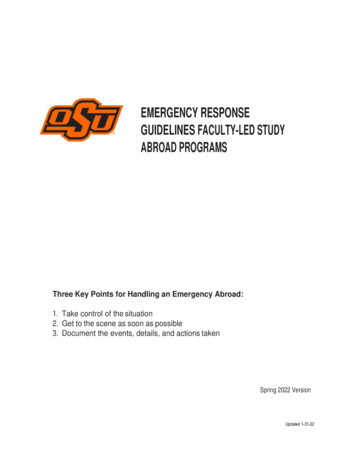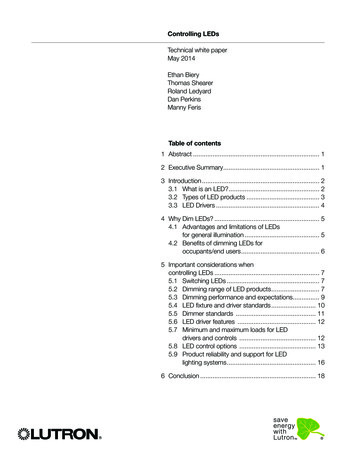
Transcription
EMERGENCY RESPONSEGUIDELINES FACULTY-LED STUDYABROAD PROGRAMSThree Key Points for Handling an Emergency Abroad:1. Take control of the situation2. Get to the scene as soon as possible3. Document the events, details, and actions takenSpring 2022 VersionUpdated 1-31-22
Something has happened! First Steps:1. Remain calm. The participants affected need you to be calm.2. Assess the situation and take control with immediate action if an emergency (calling for police,ambulance or medical professionals, gathering students together, moving to a safe location, etc.)3. Speak with the affected student(s) in private, if needed, to assess what has happened but do notpromise complete confidentiality or secrecy since you will need to discuss the situation with othersat OSU and the Assistance provider.4. Express concern, care, and willingness to help.5. Once the immediate emergency is addressed, call the OSU Travel Assistance Service, the OSUPolice Department 24-hour number, and depending on the incident and time of day your CollegeCoordinator, to report the incident and request support. Do not call the family of a victimdirectly. OSU will handle that process from Stillwater, as needed.OSU Travel Assistance Service: 1 866 693 6873 (from outside of the US) 1 312 935 9242 (from inside the US)OSU Police: 1 405 744 6523Your College Coordinator:When calling to report an incident, have the following details available: Your name and the program you are leadingYour location and immediate contact number and how long it will be validParticipant’s name(s), individuals involvedThe nature of the emergency and names of treating doctor (if relevant to the emergency)Name of hospital or other facility, if relevant to the emergencyWhen you will call back or when the OSU administrator may call youYour longer term contact number if different from your immediate contact numberWho knows about the incident (other participants, family members, etc.), if known6. Review the Emergency Response Guidelines for additional instructions on the specificemergency that has occurred.7. Take time for self-care, if needed.8. Document all that has happened**Reminder: Document, document, document. Good documentation is important! For any incident,documenting the date, who was contacted, who was involved, and what was done is important to recordkeeping and recall of incidents in case there are later questions about how the incident was handled. Takephotos of the setting if they might be helpful for future reference. Documenting includes taking note of theconversations you have with OSU Police Dispatchers and Travel Assistance Services staff. All OSUincidents abroad are entered into the Critical Incident Database (CID) and may be required for compliancewith Cleary Act reporting requirements, so no detail is too small to document.2
Table of ContentsMANDATORY STUDENT INSURANCE AND PREPAYMENTS.4POTENTIAL INCIDENTS ABROAD .51.0 LOSS OF PASSPORT FIRST-STEPS CHECKLIST .62.0 THEFT OF PERSONAL BELONGINGS FIRST-STEPS CHECKLIST .73.0 DISCIPLINE AND BEHAVIOR CONCERNS FIRST-STEPS CHECKLIST .94.0 ILLNESS or INJURY FIRST-STEPS CHECKLIST .115.0 MENTAL HEALTH CONCERNS FIRST-STEPS CHECKLIST .136.0 ALCOHOL and SUBSTANCE ABUSE FIRST-STEPS CHECKLIST .167.0 SEXUAL ASSAULT FIRST-STEPS CHECKLIST .178.0 NATURAL DISASTER FIRST-STEPS CHECKLIST .239.0 SOCIAL UNREST AND TERRORISM FIRST-STEPS CHECKLIST .2410.0 CRIMINAL BEHAVIOR OR ARREST FIRST-STEPS CHECKLIST .2511.0 MISSING STUDENT OR ABDUCTION FIRST-STEPS CHECKLIST .2612.0 EPIDEMIC FIRST-STEPS CHECKLIST .2813.0 DEATH OF A PARTICIPANT FIRST-STEPS CHECKLIST .29APPENDICES .32Appendix A. Pre-departure Checklist Example .32Appendix B. Emergency Contact Card Example .33Appendix C. Types of Incidents .34Appendix D. Incident Report Template .35Appendix E. Cancelling a Program and Evacuation .37RESOURCES .38OSU Resources .38State Department and Government Resources: .38Online Resources and Books .383
MANDATORY STUDENT INSURANCE AND PREPAYMENTSAs part of our OSU Health and Safety Program for students, the OSU mandatory student travel insuranceincludes medical pre-payment in emergency situations (see more on payments below). Depending on thenature of the emergency (see first steps on page for specific type of emergency), the insurance companymay be one of the first calls you make as they can assist in locating local hospitals, locating a medicaltranslator and help make other arrangements.If this emergency is such that the student’s injuries must be addressed urgently, the insurance companyshould be called as soon as possible after the incident. Depending on the nature of the medical situation,you or the student may call Gallagher Global Assistance at 1 312 935 9242 (from inside the US) or 1866 693 6873 (from outside of the US). The OSU policy number is GLMN14301720. They will needdetails on the injury or illness and contact information for the medical care provider if the student was takento a hospital or other facility.Note on paying for medical careStudents should be prepared to pay for all of their own medical care while abroad. They should haveaccess to an emergency credit card or other funds to pay for basic care such as visits to the doctor andminor medical treatments. It is standard for travel insurance to be on a reimbursement basis, so all receiptsshould be kept to file a claim after the treatment. If the student cannot pay for their medical care or thesituation requires a large pre-payment (such as for a surgery) OSU’s travel assistance service should becontacted immediately to arrange payment to the hospital. They can pay up to 10,000 in advance.Faculty leaders should not pay for any student medical expenses on their personal credit card unless thereis no other option, as there is no guarantee of reimbursement. In addition, state regulations for PCard usedo not allow payments for student medical care. If you believe you have no other option but to pay for astudent’s medical care using personal funds, please contact your college or department study abroadcoordinator to discuss in advance, as your college needs to agree to reimburse you or assist with collectingfunds from the student if the insurance provider declines the claim or other issues arise.4
POTENTIAL INCIDENTS ABROAD5
1.0 LOSS OF PASSPORT FIRST-STEPS CHECKLISTIf you are on-site, take care of any immediate needs first and foremost (e.g. student was injured and needsa medical evaluation, student’s hotel room was robbed and they need to go to a safe space) then Obtain details and document what happened and evaluate the situationDetermine if items were lost or taken along with the passport (wallets, phones, etc.)Depending on the country, notify the police if a theft occurred (if appropriate)Call the OSU Travel Assistance Service at 1 312 935 9242 (from inside the US) or 1 866 6936873 (from outside of the US) if information or support neededPlan with the student how they will replace the passporto Do you or they have a paper copy? If not, OSU has a digital copy to useo Do they need to get a new photograph taken?o How far are you from the Embassy or Consulate to obtain a new passport?Document what has happened!o Date and who was involvedo Who was contacted and steps takeno Take photos of the setting if they might be helpful for future referenceComplete an incident report and send to your College Coordinator. They will enter the incident intothe OSU Critical Incident Database used for Clery Reporting and other university processesADDRESSING CRISIS RESULTING FROM LOSS OF PASSPORTThe loss of a passport is extremely common but never convenient. It will take some help and logisticalplanning on your part as the course leader to help a student arrange for a replacement passport ortemporary travel documents. Here are some tips for common problems that can come up after loss of apassport:1. Missed Transportation – if the group is traveling on to another location, the student may not beable to travel with the group. Discuss with your College Coordinator to plan for who will stay withthe student and who will travel with the remaining group, or if the entire group needs to remainbehind until the problem is resolved.2. Student Misses Official Class time – the student may need to miss official class activitiesreplacing their passport. Discuss with the student your expectations for making up any missedactivities with other assignments or tasks, if needed.3. Student Cannot Fly Home – the course has ended but the student cannot board their flight home.Discuss with your College Coordinator to plan if the student will remain behind after the course toresolve the issue or if the situation requires OSU staff remaining with them until resolved.Helpful ResourceUS Department of State, Lost Passport ssports/after/lost-stolen.html6
2.0 THEFT OF PERSONAL BELONGINGS FIRST-STEPS CHECKLISTIf you are on-site, take care of any immediate needs first and foremost (e.g. student was injured and needsa medical evaluation, student’s hotel room was robbed and they need to go to a safe space) then Obtain details and document what happened and evaluate the situationDetermine the extent of items stolen (wallets, phones, passports, etc.)Depending on the country, notify the police of theft (if appropriate)Call the OSU Travel Assistance Service at 1 312 935 9242 (from inside the US) or 1 866 6936873 (from outside of the US) if information or support needed to replace documents or locate adoctorDiscuss with the student what type of support they need and contact your College Coordinator asneededo Did they lose all cash and credit cards? If so, how will they pay for personal items for theremainder of the time abroad?o Do they need to replace a passport?o Do they need a police report to submit when they get home for their personal, familyinsurance?Document what has happened!o Date and who was involvedo Who was contacted and steps takeno Take photos of the setting if they might be helpful for future referenceComplete an incident report and send to your College Coordinator. They will enter the incident intothe OSU Critical Incident Database used for Clery Reporting and other university processesCATEGORIES OF THEFT AND POSSIBLE RESPONSESTheft is unfortunately all too common when traveling. A purse is left on a table at the bar; wallets are liftedfrom jean pockets on the subway. Theft can be distressing and stressful for anyone. It will take some helpand logistical planning on your part as the course leader to help a student after a theft.There are three primary types of theft: Burglary, Larceny, and Robbery. Here are some steps for eachmanner of theft:4. Burglary – unlawful entry or remaining in a structure to commit felony or theft. In this instance, astudent has likely lost items from their room or in a classroom. They will likely want to changerooms or take other precautions since burglary can leave one feeling violated. If the items havebeen taken by a roommate, or one student accuses another of the theft, this will need to bediscussed with OSU. Also, discuss with your College Coordinator a plan for addressing a student’sneeds if they feel unsafe in space provided by OSU.5. Larceny – taking, carrying or riding away with someone else’s property. This is pickpocketing andpurse snatching, as two examples. Students may not be aware immediately they have lost an itemwhich may take time with your help to determine what happened. Students may be injured if theyare shoved to the ground or attempt to fight back against the perpetrator. Medical attention will be7
your first concern, then addressing the loss of items. Discuss with the student and your CollegeCoordinator any support needed.6. Robbery – taking personal items with force, threat, violence or fear. Students may be injured or inemotional distress since robbery can be violent or create fear for the victim. Medical attention willbe your first concern, then addressing the loss of items. Discuss with the student and your CollegeCoordinator any support needed.8
3.0 DISCIPLINE AND BEHAVIOR CONCERNS FIRST-STEPS CHECKLISTBecome familiar with prohibited conduct outlined in the OSU Student Code of Conduct.https://studentconduct.okstate.edu/code if any behavior exhibited by students aligns with the prohibitedconduct you may file a complaint with Student Conduct at https://studentconduct.okstate.edu/reportThere are three steps to follow in addressing undesired behavior:1. Confront the behavior2. Document3. Refer, if needed1. Confront the Behaviora. Depending on the severity of the behavior consider a general word of caution to the wholeclass rather than warning a particular student (e.g. “When I tell you to be ready to leave at8am, I expect that we are walking out the door at that time”).b. If the behavior continues or was more server or egregious in nature you might need to meetwith the student instead of a general word of caution.STEPSEXAMPLESClearly state the behavior causing thedisruptionWhen you arrive late it puts the whole groupbehind schedule.Give the student an opportunity to respondSet expectations going forwardI expect from here on out, you are ready fiveminutes before.Explain what will happen in the future ifexpectations are not metIf you can’t meet this expectation you will notbe allowed to have free time in the evening.Discuss resources to promote student successI suggest that you set your phone alarm,room clock, and ask for your roommate towake you up so you are on time.Document, if able, in an email to the student asummary of the conversation. If not possible,be sure you also have clear, verbal affirmationfrom the student that they understand yourconversation.2. DocumentMake written notes of any discussion, incidents, or action taken. Notes should include:9
a. Reconstruct your actions, conversations with the studentb. Dates and timesc. Reflects student awareness3. Refer, if neededa. Continued undesired behavior that violates the Student Code of Conduct can be referred toStudent Conduct. This allows for due process to be given to the student yet holds themaccountable for their actions. However, this is not necessarily an immediate solutionb. Keep your College Coordinator informed.c. Egregious incidents could result in immediate dismissal from the program. This should only bedone in consultation with relevant campus staff.Points to Considera. Eye contact, facial expressions, gestures, physical proximity to students, and the way youcarry yourself will communicate that you are in calm control of the situationb. Verbalize descriptions of the behaviors and do not make value judgments about studentsc. Do not use sarcasmd. Consider, “Am I making this worse or better?”e. Listen as much as you talkf. Stay solution focused10
4.0 ILLNESS or INJURY FIRST-STEPS CHECKLISTTake care of an urgent medical emergency first and foremost, then Obtain details and start documenting what happened Go to the participant if you are not on-site or meet them at the medical facility if they have beentransported somewhere other than the location where the illness or injury occurred Evaluate the situation If the student needs to go to the doctor, arrange medical transport to the medical facility andremain with them at the facility until they are discharged Be able to provide medical alert/allergy information to the emergency response/ medical staff Contact the OSU Travel Assistance Services at 1 312 935 9242 (from inside the US) or 1866 693 6873 (from outside of the US) for medical facility recommendations or if prepayment forservices is required Call the OSU Police at 1 405 744 6523 so they can notify appropriate staff on campus. OSU willcontact family members as needed so that you can remain focused on your students Coordinate who will stay with the ill or injured student and who will remain with the other students If life and death emergency medical decisions are needed, you may need to call the student’semergency contact directly if there is not time for OSU staff in Stillwater to assist you. In all othersituations, focus on the students on site and leave to other OSU staff to speak with family membersOnce the immediate medical emergency has passed: Record the following information:o Who is the attending physician (if any) and do they speak English?o What is the diagnosis and/or prescribed treatment?o What is the prognosis?o Are other participants at risk (physical or psychological)?o Is airlift evacuation a desirable and/or viable action?Monitor the situation - Don’t divulge information, even to the participant’s family members withouthis/her prior specific consent. Privacy law exceptions apply, however, in case of emergency andthe injured person cannot act for him or herself. At all times, be respectful of the participant’sprivacy.Other participants may learn about the incident and want to share their information. Explain thatthe participant involved in being taken care of and caution them about speculative discussion orsocial media posts. Advise them to wait until complete and accurate information is available beforethey communicate with persons at home. Keep them informed in a way that ensures confidenceas well as protects the privacy of the participant.Stay in contact with any medical personnel involved in the situation and keep your incident reportup to date. Keep the Outreach/International Program Director updated.If the student must withdraw early to return home, or needs medical evacuation, contact the OSUAssistance Services immediately at 1 312 935 9242 (from inside the US) or 1 866 693 6873(from outside of the US). They will make those flight and other arrangements.Document what has happened11
o Date and who was involvedo Who was contacted and steps takeno Take photos of the setting if they might be helpful for future referenceComplete an incident report and send to your College Coordinator. They will enter the incident intothe OSU Critical Incident Database used for Clery Reporting and other university processesReminders: NEVER leave a student alone at a hospital or other care facility. Organize an OSU employeeto remain with the students at all times until a family member is present, if the illness or injury issuch a family member travels to the location. If serious enough, OSU will send staff from Stillwaterto assist you if the emergency is that critical and family members are unable to be present at thehospital with a student. Should a family member travel to the location, provide local assistance as necessary. YourCollege Coordinator and the OSU Travel Assistance Services representatives will handle flightsand other details for family members Reminder, only in extreme circumstance and with OSU approval are you permitted to use a PCardfor student medical care. That is not an approved expense for PCard use. You are alsodiscouraged from paying with your own credit card for any student medical treatment to avoidpersonal liability issues. If care must be prepaid, contact the OSU Travel Assistance Services asthey are prepared to arrange for prepayment of care. If you must pay personally for any medicalcare, do so in consultation with your College Coordinator and others at OSU.12
5.0 MENTAL HEALTH CONCERNS FIRST-STEPS CHECKLISTIf the situation appears to be a mental health emergency, take appropriate steps to ensure the safety ofthe student and other participants as you would in any other emergency/life threatening situation.Examples of Mental Health Emergencies include (but are not limited to):a) Suicide has been attempted or student states they have a plan to kill themselvesb) Student states they plan to kill or harm someone elsec) Student has engaged in self-injury and they need immediate medical attentiond) Student is severely impaired by drugs or alcohol that requires immediate medical attention(i.e. alcohol poisoning or drug overdose) – also refer to that section of these Guidelinese) Student is engaging in unusual and erratic behavior that suggests a threat to self or others(i.e. psychotic, unable to communicate, destructive behavior) Obtain details and start documenting the situation and any related incidentsGo to the participant if you are not on-site or meet them at the medical facility if they have beentransported somewhereEvaluate the situationArrange medical transportation if necessary and stay at the medical facility until a replacementOSU staff member or family member arrives, or the student is discharged to return to the programContact the OSU Travel Assistance Services at 1 312 935 9242 (from inside the US) or 1866 693 6873 (from outside of the US) for medical facility recommendations or if prepayment forservices is requiredCall the OSU Police at 1 405 744 6523 so they can notify appropriate staff on campus. OSU willcontact family members as needed so that you can remain focused on your student(s)Coordinate on site OSU staff who will stay with student experiencing an emergency and who willremain with the other students(See next page)13
In cases where a student is in acute distress or requests to speak with a counselor for a non-emergency,contact the OSU Travel Assistance Services at 1 312 935 9242 (from inside the US) or 1 866 6936873 (from outside of the US) for local counselor recommendations. You should also notify your CollegeCoordinator so they are aware of and can support you as needed, along with other professional staff oncampus.Examples of Acute Distress include (but are not limited to):a) Student threatens to attempt suicide at some point in the near futureb) Student is engaging in threatening behaviors or gestures towards othersc) Student has engaged in self-injury (cutting, scratching, etc) and states they are havingserious thoughts of suicided) Student is engaging in odd behavior that is concerning and causing some disruptionExamples of Non-emergencies include (but are not limited to):a) Student has engaged in self-harm (cutting, scratching, etc) and denies thoughts of suicideb) Student has threatened to engage in self-harm and denies thoughts of suicidec) Student states they have thoughts of suicide but deny any intent to harm themselves andstate they would never take action on the thoughtsd) Student is upset and requests to speak with a counselor (relationship break up, past abuse,past trauma)Once the emergency or immediate situation has passed: Document the behavior, related incidents, and any response to the situation by OSU staff, otherparticipants, and local responders/care providersAsk participants to report if a peer’s behavior is hampering their ability to learn or to get the mostout of their program. (Do not however call out potentially disruptive students by name to otherstudents)Contact your College Coordinator with updates and if you notice indications of a potential problemor that a non-emergency situation is becoming a mental health emergencyIf medical professionals determine the student needs to return to the USA for additional care orcannot rejoin the course in progress, the OSU Travel Assistance Services should be engaged tomanage that process and arrange for transportationGeneral Reminders for Mental Health Issues1) Prior to departure: familiarize yourself with the local resources for both on-going psychological andpsychiatric care as well as emergency services.2) Become aware of signs of distressThe most frequent conditions reported on study abroad may include:14
· Anxiety symptoms and panic attacks· Depression· Self harm· Eating disorders· Chronic alcohol or prescription drug abuseThe University Counseling Services website lists signs and symptoms of .html3) Reminder, only in extreme circumstance and with OSU approval are you permitted to use a PCardfor student medical care. That is not an approved expense for PCard use. You are also discouragedfrom paying with your own credit card for any student medical treatment to avoid personal liabilityissues. If care must be prepaid, contact the OSU Travel Assistance Services as they are prepared toarrange for prepayment of care. If you must pay personally for any medical care, do so in consultationwith your College Coordinator and others at OSU.4) NEVER leave a student alone at a hospital or other care facility. Organize an OSU employee toremain with the students at all times until a family member is present, if the situation is such a familymember travels to the location. If serious enough, OSU will send staff from Stillwater to assist you ifthe emergency is that critical and family members are unable to be present with a student.Should a family member travel to the location, provide local assistance as necessary. Your CollegeCoordinator and the OSU Travel Assistance Services representatives will handle flights and otherdetails for family members15
6.0 ALCOHOL and SUBSTANCE ABUSE FIRST-STEPS CHECKLISTConsequences of excessive alcohol use and other drugs are common on campus and those behaviorstravel easily to the study abroad space, potentially disrupting your course and student learning experiences.Local drinking or drug cultures that may be different from the United States, potency of alcohol that mayvary from typical drinks in Stillwater, a variety of legal drinking ages, the legality and availability of drugs,and stress of being in an unfamiliar environment can all influence student behavior abroad. If youencounter a student who may be overconsuming any variety of substances: Treat the situation seriously while remaining objective. Do not judge but also do not ignore whatcould be or become a serious health incidentIf you suspect alcohol poisoning or some kind of overdose, contact emergency medical careimmediatelyContact the OSU Travel Assistance Services at 1 312 935 9242 (from inside the US) or 1866 693 6873 (from outside of the US) if you need to refer the student to a medical facility orother careCall the OSU Police at 1 405 744 6523 if the situation warrants contacting family members sothey can notify appropriate staff on campus who will reach out to the student’s emergencycontacts.If a student is hospitalized or needs medical care, coordinate who will stay with them until they aredischarged or in worst-case scenarios a family member arrives. Reminder, never leave a studentalone without an OSU employee representative at a hospital or medical facility.Once you have addressed the immediate incident, or in cases where there are ongoing problems: Discuss the situation with your College Coordinator, if not done alreadyDocument the incident(s) for future reference should disciplinary action be requiredHold the student responsible for their behavior and actionsRemind the student of behavior expectations, if appropriate in the situation (for example, arrivingon time for class meetings)Remind the student of the disciplinary process and explain consequences of misbehaviorDiscuss the incident with OSU Student Conduct if the situation warrants. Your College Coordinatorand the Center for Global Learning can assist with that, if needed.Complete an incident report and send to your College Coordinator. They will enter the incident intothe OSU Critical Incident Database used for Clery Reporting and other university processes16
7.0 SEXUAL ASSAULT FIRST-STEPS CHECKLIST Take any report of sexual assault seriously and respond quickly. Do not ignore or minimize thesituation Ensure the immediate safet
GUIDELINES FACULTY-LED STUDY ABROAD PROGRAMS Three Key Points for Handling an Emergency Abroad: 1. Take control of the situation 2. Get to the scene as soon as possible 3. Document the events, details, and actions taken Spring 2022 Version . 2 Something has happened! First Steps:




![Amalfi 180 Led Otto [28.01.22]](/img/23/022e99f7-d57e-51b4-8c41-152437a0d633.jpg)





